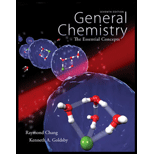
Concept explainers
(a)
Interpretation:
The unknown electrode ‘X’ has to be identified.
Concept introduction:
Standard reduction potential: The voltage associated with a reduction reaction at an electrode when all solutes are 1M and all gases are at 1 atm. The hydrogen electrode is called the standard hydrogen electrode (SHE).
Standard emf:
Where both
(a)
Explanation of Solution
The standard reduction potential of Mg (+2) as follows,
The standard reduction potential of Pb (+2) as follows,
Calculated standard emf for galvanic cell as follows,
Therefore, the cathode emf is
(b)
Interpretation:
The unknown electrode ‘X’ has to be identified.
Concept introduction:
Standard reduction potential: The voltage associated with a reduction reaction at an electrode when all solutes are 1M and all gases are at 1 atm. The hydrogen electrode is called the standard hydrogen electrode (SHE).
Standard emf:
Where both
(b)
Explanation of Solution
The standard reduction potential of Mg (+2) as follows,
The standard reduction potential of Pb (+2) as follows,
Calculated standard emf for galvanic cell as follows,
The given standard emf of the
Therefore, the cathode emf is
c)
Interpretation:
The unknown electrode ‘X’ has to be identified.
Concept introduction:
Standard reduction potential: The voltage associated with a reduction reaction at an electrode when all solutes are 1M and all gases are at 1 atm. The hydrogen electrode is called the standard hydrogen electrode (SHE).
Standard emf:
Where both
c)
Explanation of Solution
The standard reduction potential of Mg (+2) as follows,
The standard reduction potential of Pb (+2) as follows,
Calculated standard emf for galvanic cell as follows,
The given standard emf of the redox reaction is,
Therefore, the cathode emf is
d)
Interpretation:
The unknown electrode ‘X’ has to be identified.
Concept introduction:
Standard reduction potential: The voltage associated with a reduction reaction at an electrode when all solutes are 1M and all gases are at 1 atm. The hydrogen electrode is called the standard hydrogen electrode (SHE).
Standard emf:
Where both
d)
Explanation of Solution
The standard reduction potential of Mg (+2) as follows,
The standard reduction potential of Pb (+2) as follows,
Calculated standard emf for galvanic cell as follows,
The given standard emf of the redox reaction is,
Therefore, the cathode emf is
Want to see more full solutions like this?
Chapter 19 Solutions
Package: General Chemistry with Connect 2-year Access Card
 ChemistryChemistryISBN:9781305957404Author:Steven S. Zumdahl, Susan A. Zumdahl, Donald J. DeCostePublisher:Cengage Learning
ChemistryChemistryISBN:9781305957404Author:Steven S. Zumdahl, Susan A. Zumdahl, Donald J. DeCostePublisher:Cengage Learning ChemistryChemistryISBN:9781259911156Author:Raymond Chang Dr., Jason Overby ProfessorPublisher:McGraw-Hill Education
ChemistryChemistryISBN:9781259911156Author:Raymond Chang Dr., Jason Overby ProfessorPublisher:McGraw-Hill Education Principles of Instrumental AnalysisChemistryISBN:9781305577213Author:Douglas A. Skoog, F. James Holler, Stanley R. CrouchPublisher:Cengage Learning
Principles of Instrumental AnalysisChemistryISBN:9781305577213Author:Douglas A. Skoog, F. James Holler, Stanley R. CrouchPublisher:Cengage Learning Organic ChemistryChemistryISBN:9780078021558Author:Janice Gorzynski Smith Dr.Publisher:McGraw-Hill Education
Organic ChemistryChemistryISBN:9780078021558Author:Janice Gorzynski Smith Dr.Publisher:McGraw-Hill Education Chemistry: Principles and ReactionsChemistryISBN:9781305079373Author:William L. Masterton, Cecile N. HurleyPublisher:Cengage Learning
Chemistry: Principles and ReactionsChemistryISBN:9781305079373Author:William L. Masterton, Cecile N. HurleyPublisher:Cengage Learning Elementary Principles of Chemical Processes, Bind...ChemistryISBN:9781118431221Author:Richard M. Felder, Ronald W. Rousseau, Lisa G. BullardPublisher:WILEY
Elementary Principles of Chemical Processes, Bind...ChemistryISBN:9781118431221Author:Richard M. Felder, Ronald W. Rousseau, Lisa G. BullardPublisher:WILEY





